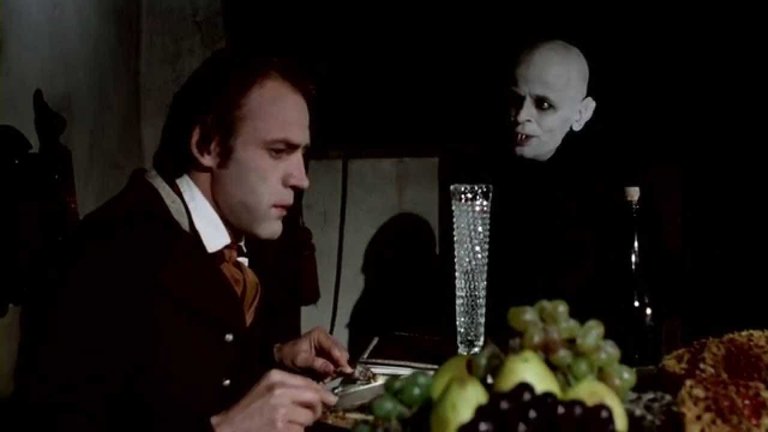Film Review: Nosferatu the Vampyre (Nosferatu: Phantom der Nacht, 1979)

1979 was very good year for Count Dracula on silver screen, at least judging by the number of titles featuring Bram Stoker’s iconic character. Apart from John Badham’s Dracula, arguably the most faithful of all adaptations of the original novel, many films in that year directly and indirectly tried to exploit legendary icon of horror genre, and even Communist Romania contributed to the trend with Vlad Ţepeş, epic dedicated to real historical figure that had inspired Bram Stoker. For the audience more inclined to films with artistic ambition, the best Dracula film that year was Nosferatu the Vampyre, Franco-West German co-production directed by Werner Herzog.
The film begins with disturbing images of mummified corpses, which is soon to be revealed a nightmarish vision of Lucy Harker (played by Isabelle Adjani), young beautiful woman living in 19th Century German city of Wismar. Her husband, real estate agent Jonathan (played by Bruno Ganz), has been tasked to help mysterious Count Dracula in buying house in Wismar. Despite Lucy begging him not to go, he travels to Transylvania to sign the contract with the Count. There he encounters locals unwilling to help him reach Count’s mountain castle and Jonathan is forced to go alone. There he finally meets Count (played by Klaus Kinski), who is revealed as grotesquely hideous and almost un-human creature with pale skin, long nails and sharp rat-like fangs. When Jonathan accidentally cuts himself during bizarre supper Count reveals his strange fondness for drinking human blood, as well as obsession with Lucy’s image in Jonathan’s locket. That and many other incidents convinces Jonathan that he Count Dracula is actually a vampire, but by that time it is too late. With the contract signed, Dracula arranges himself to be transported in coffin boarded at ship for Wismar. When he arrives, he brings with him thousands of rats and the plague that would devastate the city. Jonathan arrives too, but he is of little use, being struck by what Doctor Van Helsing (played by Walter Ladengast) calls “brain fever”. Lucy reads her husband’s journal and becomes the only person who knows what Dracula is, why he is obsessed with her and how to destroy him. She decides to set up a trap that would kill Dracula but also sacrifice her own life.
Nosferatu the Vampyre works less as an adaptation of Bram Stoker’s novel and more as the remake of Nosferatu, 1922 silent film by F.W. Murnau, known as one of the classics of German Expressionism in cinema. Herzog, who claims that this legendary version is the best Dracula film ever made, went into this project with clear intention to pay homage, and it is reflected not only in his old collaborator Klaus Kinski becoming almost unrecognisable by being made up to look almost exactly like Max Shreck in 1922 version, but also in many static shots that pay homage to Murnau’s film. On the other hand, Herzog tries to combine this approach with his own style, with semi-documentary scenes that show breath-taking Carpathian locations. That combination of Gothic iconography and realism isn’t always fortunate and Nosferatu, especially in opening segments, looks like cheap television production. Only in latter segments it starts looking like a grand film due to disturbing scenes of thousands of rats invading city streets, as well as endless funeral processions.
This disturbing vision is somewhat compromised with Herzog’s attempts to inject some black humour, especially at the end, when he indulges in little revisionism. For example, Van Helsing in this film is revealed to be pathetic useless old man, and Lucy’s failed attempts to ask her fellow citizens of plague-stricken Wismar and the city’s descent into anarchy could be interpreted as Herzog’s anti-establishment views being projected into Gothic story. This, just like the ironic ending doesn’t hurt the film too much, but Nosferatu nevertheless looks little bit incoherent. Thankfully, brilliant and iconic performance of Kinski is here to save the day, and Adjani with her almost supernatural angelic beauty is perfect choice for the role of Lucy. With those two strong performances and even with Ganz being completely overshadowed by those two, Nosferatu will provide memorable viewing experience and satisfy even the audience that prefers more conventional approach to horror genre.
RATING: 7/10 (++)
Blog in Croatian https://draxblog.com
Blog in English https://draxreview.wordpress.com/
Leofinance blog https://leofinance.io/@drax.leo
Cent profile https://beta.cent.co/@drax
Minds profile https://www.minds.com/drax_rp_nc
Uptrennd profile https://www.uptrennd.com/user/MTYzNA
Hiveonboard: https://hiveonboard.com?ref=drax
Rising Star game: https://www.risingstargame.com?referrer=drax
1Inch: https://1inch.exchange/#/r/0x83823d8CCB74F828148258BB4457642124b1328e
BTC donations: 1EWxiMiP6iiG9rger3NuUSd6HByaxQWafG
ETH donations: 0xB305F144323b99e6f8b1d66f5D7DE78B498C32A7

https://twitter.com/draxblog/status/1380195862190624769